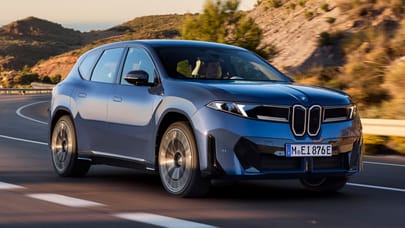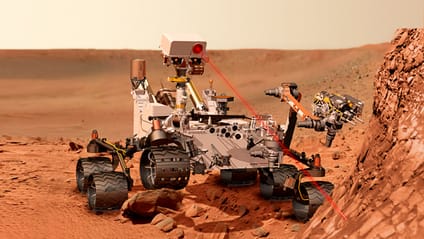
How to drive on Mars
First, get there. Next, go through immigration. Then it's a case of passing a Martian driving test


They called it the Seven Minutes of Terror. Over 33 million miles from Earth, the capsule carrying the Curiosity rover broke through the thin Mars atmosphere and unfurled a 16-metre-wide supersonic parachute, to slow it from its eight-month journey at a stellar cruising speed of 22,500mph. Four thrusters fired up to slow it even more, transforming the spacecraft into a skycrane that gently lowered its $2.5 billion payload on to the surface of the Red Planet. A touch too fast, and nearly a tonne of rover plus years of hard work would have burst on impact, showering the alien desert with a giant Meccano set for some flubbery creature to discover in the distant future.
Words: Dan Read
Photos: NASA/JPL-Caltech
This feature first appeared in the October 2012 issue of Top Gear magazine
Advertisement - Page continues below
After substantial reassembly, our Martian friend would be presented with a vehicle the size of a Range Rover. It has six wheels, 20in titanium rims with tracked metal ‘tyres', linked to a chassis by spidery suspension. On the front is a robotic arm - one of 10 on-board instruments - to grab rocks, which it feeds into its belly to be analysed by a mobile lab. It has cameras capable of zooming to the width of a human hair, and there's a laser to zap things up to seven metres away, vaporising thin layers of material while other equipment figures out what sort of atoms they release. All this is powered by a plutonium battery, which makes electricity from the heat of radioactive decay.
And although it won't be finding wriggly microbes in icy ponds, its basic job - like previous Mars rovers, only more advanced - is to see if anything could actually live up there. But the scientists would be somewhat bored if it weren't for their colleagues at NASA's Jet Propulsion Laboratory. The drivers. There's a team of 16, working in shifts synced to Mars time. With a day - or ‘sol' - lasting 40 minutes longer than on Earth, each start time is later than the last. It's like having jet lag without actually going anywhere apart from the office. What we have here, then, is the ultimate remote-control car. But due to a time delay of roughly 13 minutes each way, the team isn't hooked up to a steering wheel via some live space stream.

"By the time you saw a rock in the way and hit stop, it'd be too late," explains Matt Heverly, one of the Mars drivers. "So what we do is plan a route, then write a list of simple text commands... drive forward a metre, turn left, take a picture, and so on." Matt and the team talk to the rover twice a day: once in the morning with a batch of instructions, and once in the evening when the rover emails back a report of its work. "Then it will go to sleep, as it's too cold to operate overnight," he says. "While it rests, we're furiously planning the next day's activity."
Just yesterday, they saw the results of Curiosity's first drive, a black and white image showing tyre tracks behind the rover, containing blocks of Morse code spelling out ‘JPL' (partly a message to little green men; mostly a way to plot the distance between drives). "We were sitting there, hitting refresh, waiting for the data to come down," says Matt. "As soon as you see that image, you know whether or not your simulations have worked. It's a big sigh of relief when you see it did what you asked." It only travelled a short distance, but this thing isn't exactly quick. "It's essentially quasi-static - our absolute top speed is 0.1mph, and it has no real dynamics," he says. It travels so slowly that it doesn't even need damped suspension, going instead with a kinematic - but very dextrous - system of links and joints that keep its weight neatly spread over all six wheels as it creeps over rocks up to 50cm tall.
Advertisement - Page continues below
On top of that, it has a complex brain containing a sort of terrain-response system, similar to the one in a Land Rover. Except here, it's NASA-grade. Once it receives a text command, it breaks it down into over 4,000 parameters and figures out exactly how to perform it. It may have landed on hard-packed soil, but as it travels over the Martian surface it'll pass through soft sand and substances impossible to recreate back on Earth. To stop it from falling over, sensors monitor tilt angles, while others measure the speed of the steering actuators. If it encounters any unexpected obstacles, it'll stop and call home for help. "We set different limits," says Matt. "You're basically programming how it responds to the environment, like you would with how a car responds to a sharp turn or acceleration."
All the while, cameras on its mast are taking hi-def images of the extraterrestrial surroundings. You can see the results for yourself on these pages. What you can't see is a stereo version, a 3D ‘terrain mesh' the drivers can view through goggles at the JPL. In a flat image, it's hard to judge how far away the horizon might be, or how close a ridgeline really is. With an extra dimension plus clever animation software, the drivers can calculate the safest route through the landscape. Anything under 25cm isn't a worry, but big boulders and soft ground could trap the rover. To avoid such things, they've hired video gamers to help them interpret what they see, supergeeks unhealthily talented in games like World of Warcraft, who navigate weird worlds from their bedrooms every day. Once a route is chosen, it's uplinked to Mars at the speed of light, and Matt heads home to put the kids to bed.

"It's that moment when you leave for the day that's most impactful," he says. It's his job to keep Curiosity safe, and he'll have to wait until the next day to see if he has. Like most of the drivers, he's a mechanical engineer and treats the task of operating this thing with a cool detachment, making judgements based on proper data rather than performing slow-mo burnouts in the dust. Some might have more active imaginations, having been brought up on sci-fi books and dreams of space travel. Matt just likes robots. "I love robots that vacuum floors, weld cars... or drive on Mars," he says. "They're all amazing mechanisms."
And what if it all goes wrong? Things have come a long way since the days of Apollo, where engineers would break and fix replica models on Earth - duct-taping Lunar Rover fenders - before radioing instructions to astronauts on the Moon. This time, they still have replicas, including one that weighs the same on Earth as Curiosity does in the reduced gravity of Mars. They call it Scarecrow, due to a lack of brains, and it helps with one of the main problems for the rover: wheel slippage. "We actually use motion-tracking systems used in Hollywood - we fit little reflective balls over the rover and record it with cameras," says Matt. "Because when we send the command to drive ten metres up a slope, it might lose traction and only go five. With the tracking, we can see what slip might occur, which we feed into the planning cycles."
If the worst were to happen, it might not be so bad. A previous rover, Spirit, dropped a wheel into soft soil. The drivers figured out a way for it to carry on, dragging its lame limb behind it, which ploughed up the surface and exposed a brilliant white substance previously unknown to science. "Exploration has an inherent risk," says Matt. "We're finding new things, but that's what makes it risky." It's an exciting paradox. But with guys like Matt behind the wheel, Curiosity has a decent shot of making it through the deep canyons and up the 3.4-mile Mount Sharp in two years from now. But they only have one chance. After all, as Matt says, it's hard to send a repair man to Mars...
Trending this week
- Long Term Review
How efficient is the hybrid Dacia Bigster?







